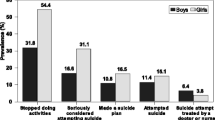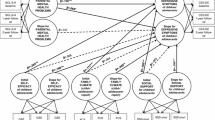Abstract
Depressive feelings and suicidal ideation in a non-clinical sample of adolescents in Estonia were analysed in the context of family structure, mutual relationships amongst family members and schoolchildren’s preferences regarding intimate personal contacts with particular family members. Data from the WHO collaborative study ‘Health Behaviour in School-aged Children 2005/2006’ (HBSC) were used. A representative sample of schoolchildren aged 11, 13 and 15 years completed the semi-structured questionnaire. The analyses included only adolescents living in households with at least one birth parent. The subjects were 4,389 schoolchildren (2,178 boys and 2,211 girls), who were divided into three groups based on: (1) suicidal thoughts, with or without depressive feelings; (2) depressive feelings; and (3) neither suicidal thoughts nor depressive feelings. Multinomial logistic regression was used. The proportion of depressive feelings increased with age for both boys and girls. Girls expressed depressive feelings more frequently than boys from ages 13 and 15 years, and suicidal thoughts from age 15 years. Self-reported satisfaction with relationships in the family reduced the likelihood of depressive feelings and suicidal thoughts. Good communication with the parents reduced the likelihood of suicidal thoughts in all age groups. Adolescents who were satisfied with their family relationships suffered less frequently from depressive feelings and suicidal thoughts. The best environment for an adolescent was a family with both birth parents. Of the adolescents in ‘non-intact’ families, those with a step-parent in the family showed suicidal thoughts more frequently than those in single-parent families. Associations between family-related variables and suicidal thoughts were significant even after adjusting for family economic deprivation score.
Similar content being viewed by others
References
Mann JJ, Waternaux C, Haas GL, Malone KM (1999) Toward a clinical model of suicidal behavior in psychiatric patients. Am J Psychiatry 156:181–189
Paykel ES (1974) Suicidal feelings in the general population: a prevalence study. Br J Psychiatry 124:460–469
Wasserman D (2001) A stress-vulnerability model and the development of the suicidal process. In: Wasserman D (ed) Suicide—an unnecessary death. Martin Dunitz Ltd, London, pp 13–28
Kaltiala-Heino R, Rimpela M, Marttunen M, Rimpela A, Rantanen P (1999) Bullying, depression, and suicidal ideation in Finnish adolescents: school survey. Br Med J 319:348–351
Larsson B, Melin L (1992) Prevalence and short-term stability of depressive symptoms in schoolchildren. Acta Psychiatr Scand 85:17–22
Saluja G, Iachan R, Scheidt PC, Overpeck MD, Sun W, Giedd JN (2004) Prevalence of and risk factors for depressive symptoms among young adolescents. Arch Pediatr Adolesc Med 158:760–765
Viñas F, Canals J, Gras ME, Ros C, Domènech-Llaberia E (2002) Psychological and family factors associated with suicidal ideation in pre-adolescents. Span J Psychol 5:20–28
Apter A (2003) Biological factors influencing suicidal behavior in adolescents. In: King RA, Apter A (eds) Suicide in children and adolescents. University Press, Cambridge, pp 118–149
Fergusson DM, Woodward LJ, Horwood LJ (2000) Risk factors and life processes associated with the onset of suicidal behaviour during adolescence and early adulthood. Psychol Med 30:23–39
King CA, Merchant CR (2008) Social and interpersonal factors relating to adolescent suicidality: a review of the literature. Arch Suicide Res 12:181–196
Koplin B, Agathen J (2002) Suicidality in children and adolescents: a review. Curr Opin Pediatr 14:713–717
Lau JYF, Rijsdijk F, Gregory AM, McGuffin P, Eley TC (2007) Pathways to childhood depressive symptoms: the role of social, cognitive, and genetic risk factors. Develop Psychol 43:1402–1414
Mortensen PB, Agerbo E, Erikson T, Qin P, Westergaard-Nielsen N (2000) Psychiatric illness and risk factors for suicide in Denmark. Lancet 355:9–12
Statham DJ, Heath AC, Madden PA, Bucholz KK, Bierut L, Dinwiddie SH, Slutske WS, Dunne MP, Martin NG (1998) Suicidal behaviour: an epidemiological and genetic study. Psychol Med 28:839–855
Zambon A, Lemma P, Borraccino A, Dalmasso P, Cavallo F (2006) Socio-economic position and adolescents’ health in Italy: the role of the quality of social relations. Eur J Public Health 16:627–632
Bhatia SK, Bhatia SC (2007) Childhood and adolescent depression. Am Fam Physician 75:73–80
Zalsman G, Brent DA, Weersing VR (2006) Depressive disorders in childhood and adolescence: an overview: epidemiology, clinical manifestation and risk factors. Child Adolesc Psychiatr Clin N Am 15:827–841
Wasserman D (2006) Depression in childhood and adolescence. Wasserman D (ed) Depression: the facts. Oxford University Press, Oxford, pp 43–61
Pfeffer CR (1981) The family system of suicidal children. Am J Psychother 35:330–341
Garber J, Little S, Hilsman R, Weaver KR (1998) Family predictors of suicidal symptoms in young adolescents. J Adolesc 21:445–457
Summerville MB, Kaslow NJ, Abbate MF, Cronan S (1994) Psychopathology, family functioning, and cognitive style in urban adolescents with suicide attempts. J Abnorm Child Psychol 22:221–235
Morano CD, Cisler RA, Lemerond J (1993) Risk factors for adolescent suicidal behavior: loss, insufficient familial support, and hopelessness. Adolescence 28:851–865
Cauce AM, Mason C, Gonzales N, Hiraga Y, Liu G (1996) Social support during adolescence: methodological and theoretical considerations. In: Hurrelmann K, Hamilton SF (eds) Social problems and social contexts in adolescence: perspectives across boundaries. Aldine de Gryter, New York, pp 131–152
McFarlane AH, Bellissimo A, Norman GR, Lange P (1994) Adolescent depression in a school-based community sample: preliminary findings on contributing social factors. J Youth Adolesc 23:601–620
Ram B, Hou F (2003) Changes in family structure and child outcomes: roles of economic and familial resources. Policy Stud J 31:309–330
Luoma I, Puura K, Tamminen T, Kaukonen P, Piha J, Rasanen E, Kumpulainen K, Moilanen I, Koivisto AM, Almqvist F (1999) Emotional and behavioural symptoms in 8–9-year-old children in relation to family structure. Eur Child Adolesc Psychiatry 8(Suppl 4):29–40
Hirsch J, Ellis JB (1995) Family support and other social factors precipitating suicidal ideation. Int J Soc Psychiatry 41:26–30
Torsheim T, Ravens-Sieberer U, Hetland J, Välimaa R, Danielson M, Overpeck M (2006) Cross-national variation of gender differences in adolescent subjective health in Europe and North America. Soc Sci Med 62:815–827
Currie C, Gabhainn SN, Godeau E, Roberts C, Smith R, Currie D, Picket W, Richter M, Morgan A, Barnekow V (2008) Inequalities in young people’s health: HBSC international report from the 2005/2006 Survey. WHO Regional Office for Europe, Copenhagen, 2008 (Health Policy Child and Adolesc No. 5)
Sabbath JC (1969) The suicidal adolescent: the expendable child. In: Maltsberger JT, Goldblatt MJ (eds) Essential papers on suicide. New York University Press, New York, pp 185–199
Varnik A, Kolves K, Allik J, Arensman E, Aromaa E, van Audenhove C, Bouleau JH, van der Feltz-Cornelis CM, Giupponi G, Gusmao R, Kopp M, Marusic A, Maxwell M, Oskarsson H, Palmer A, Pull C, Realo A, Reisch T, Schmidtke A, Sola VP, Wittenburg L, Hegerl U (2009) Gender issues in suicide rates, trends and methods among youths aged 15–24 in 15 European countries. J Affect Disord 13:216–226
Roberts C, Currie C, Samdal O, Currie D, Smith R, Maes L (2007) Measuring the health and health behaviours of adolescents through cross-national survey research: recent developments in the Health Behaviour in School-aged Children (HBSC) study. J Public Health 15:179–186
Currie C, Samdal O, Boyce W (2001) Health behaviour in school-aged children: a World Health Organization cross-national Study Research Protocol for the 2001/2002 survey. Child and Adolescent Health Research Unit, University of Edinburgh, Edinburgh
Haugland S, Wold B (2001) Subjective health complaints in adolescence reliability and validity of survey methods. J Adolesc 24:611–624
Currie C, Molcho M, Boyce W, Holstein B, Torsheim T, Richter M (2008) Researching health inequalities in adolescents: the development of the Health Behaviour in School-Aged Children (HBSC) family affluence scale. Soc Sci Med 66:1429–1436
Richter M, Erhart M, Vereecken CA, Zambon A, Boyce W, Gabhainn SN (2009) The role of behavioural factors in explaining socio-economic differences in adolescent health: a multilevel study in 33 countries. Soc Sci Med 69:396–403
Torsheim T, Currie C, Boyce W, Kalnins I, Overpeck M, Haugland S (2004) Material deprivation and self-rated health: a multilevel study of adolescents from 22 European and North American countries. Soc Sci Med 59:1–12
Samm A, Varnik A, Tooding LM, Sisask M, Kolves K, von Knorring AL (2008) Children’s depression inventory in Estonia. Single items and factor structure by age and gender. Eur Child Adolesc Psychiatry 17:162–170
Thomson E, Hanson TL, McLanahan SS (1994) Family structure and child well-being: economic resources vs. parental behaviors. Soc F 73:221–242
Verhulst FC, Van Der Ende JAN (1997) Factors associated with child mental health service use in the community. J Am Acad Child Adolesc Psychiatry 36:901–909
Garnefski N, Diekstra RFW (1997) Adolescents from one parent, stepparent and intact families: emotional problems and suicide attempts. J Adolesc 20:201–208
Hollis C (1996) Depression, family environment, and adolescent suicidal behavior. J Am Acad Child Adolesc Psychiatry 35:622–630
Prinstein MJ, Boergers J, Spirito A, Little TD, Grapentine WL (2000) Peer functioning, family dysfunction, and psychological symptoms in a risk factor model for adolescent inpatients’ suicidal ideation severity. J Clin Child Psychol 29:392–405
Reinherz HZ, Giaconia RM, Pakiz B, Silverman AB, Frost AK, Lefkowitz ES (1993) Psychosocial risks for major depression in late adolescence: a longitudinal community study. J Am Acad Child Adolesc Psychiatry 32:1155–1163
Kaslow NJ, Rehm LP, Siegel AW (1984) Social-cognitive and cognitive correlates of depression in children. J Abnorm Child Psychol 12:605–620
Ravens-Sieberer U, Torsheim T, Hetland J, Vollebergh W, Cavallo F, Jericek H, Alikasifoglu M, Välimaa R, Ottova V, Erhart M (2009) Subjective health, symptom load and quality of life of children and adolescents in Europe. Int J Public Health 54:151–159
Adams DM, Overholser JC, Lehnert K (1994) Perceived family functioning and adolescent suicidal behavior. J Am Acad Child Adolesc Psychiatry 33:498–507
Kennedy GE, Kennedy CE (1993) Grandparents: a special resource for children in stepfamilies. The stepfamily puzzle: intergenerational influences. Haworth Press Inc, NY
Steelman LC, Powell B, Werum R, Carter S (2002) Reconsidering the effects of sibling configuration: recent advances and challenges. Annu Rev Sociol 28:243–269
Blum RW, Beuhring T, Shew ML, Bearinger LH, Sieving RE, Resnick MD (2000) The effects of race/ethnicity, income, and family structure on adolescent risk behaviors. Am J Public Health 90:1879–1884
King RA, Schwab-Stone M, Flisher AJ, Greenwald S, Kramer RA, Goodman SH, Lahey BB, Shaffer D, Gould MS (2001) Psychosocial and risk behavior correlates of youth suicide attempts and suicidal ideation. J Am Acad Child Adolesc Psychiatry 40:837–846
Acknowledgments
This study was made possible within the framework of the Estonian Science Foundation’s Project No. 7132 and Doctoral School of Estonian Centre of Behavioural and Health Sciences. HBSC is an international study carried out in collaboration with WHO/EURO. The International Coordinator of the HBSC 2005/06 survey was Candace Currie and the data bank manager was Oddrun Samdal. Thanks are due to Clare James for her thorough linguistic and stylistic revision of the manuscript.
Author information
Authors and Affiliations
Corresponding author
Rights and permissions
About this article
Cite this article
Samm, A., Tooding, LM., Sisask, M. et al. Suicidal thoughts and depressive feelings amongst Estonian schoolchildren: effect of family relationship and family structure. Eur Child Adolesc Psychiatry 19, 457–468 (2010). https://doi.org/10.1007/s00787-009-0079-7
Received:
Accepted:
Published:
Issue Date:
DOI: https://doi.org/10.1007/s00787-009-0079-7




